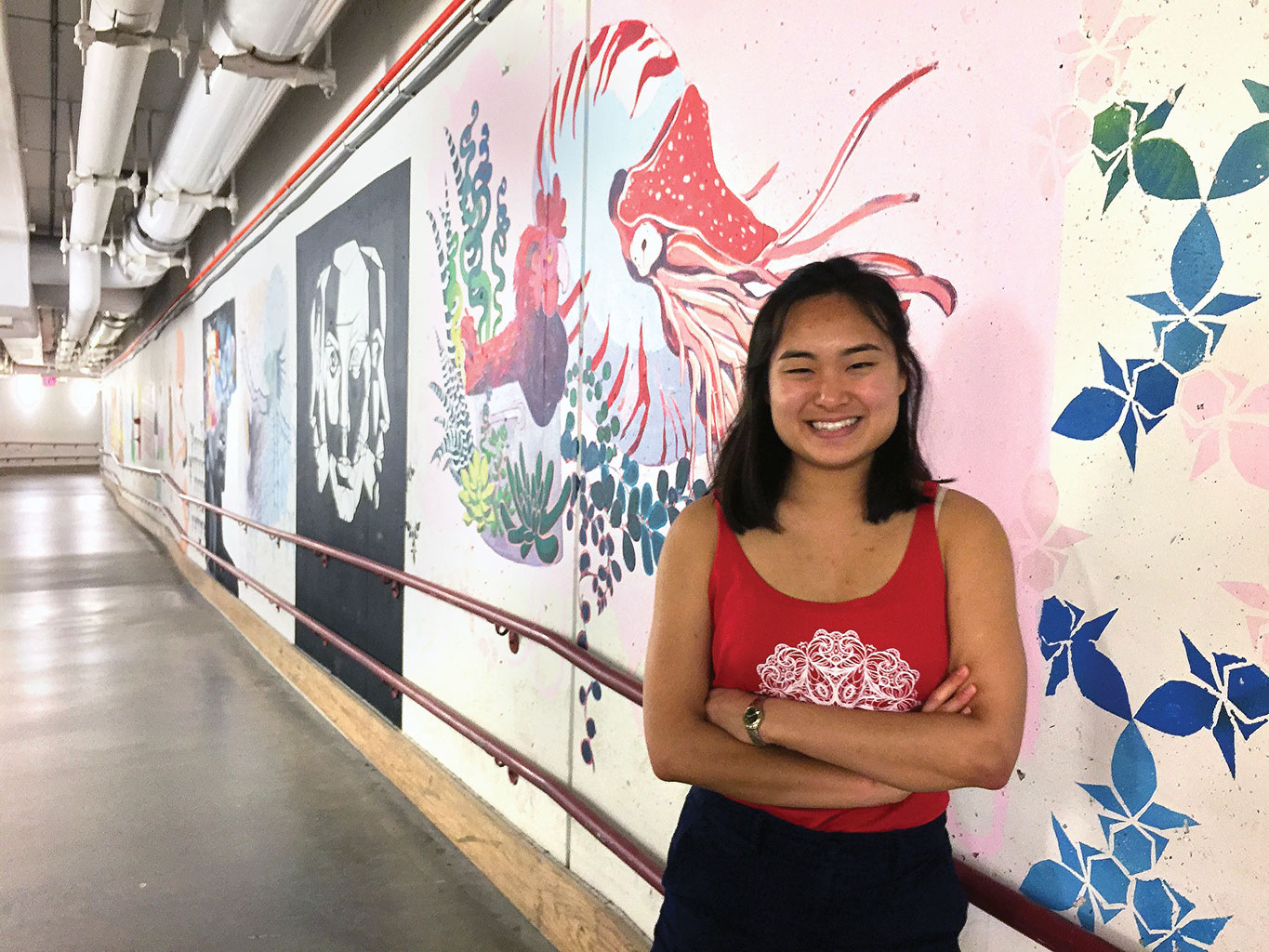
The 3 a.m. stillness of Building 68 was interrupted by groans of defeat: “It doesn’t fit.” For the third time that night, a tilted three-foot wooden cube was pushed to a doorway, resisted by the doorframe, and rerouted.
The chipboard box bulged slightly in the middle, held together by screws and staples; my 2.007 professor would have been disappointed had he witnessed its inexact construction earlier that night. We were attempting to transport the box from the Media Lab shop to the tunnel beneath Building 68, but we’d discovered that the only doors through which the box could fit were locked at 3 a.m. So we lugged it back to the Media Lab basement hallway, plastering it with signs saying “DO NOT THROW AWAY!” to protect its contents: $700 worth of paint, 10-gallon buckets, brushes, and paint tarps.
I’d long wanted to do a public art project at MIT, and as I walked through the tunnels under Ames Street, the walls seemed to wink at me. They were the perfect blank canvas. Envisioning colorful artwork brightening the somewhat drab underground walk from Main Campus to East Campus, I had the idea that giving students creative freedom in a large space would reveal the inventiveness and skills of many unknown MIT artists—and augmented reality could add an unexpected component. I applied for and was awarded a Council for the Arts at MIT (CAMIT) grant that would let student artists transform a 200-foot section of the tunnel walls into an augmented-reality mural.
Once we finally got the materials box to the mural site, what we called the Borderline tunnel art project officially got under way. In all, 25 student artists would paint murals along the wall, nine students would create six short animations to go with the paintings, and two other students would create iOS and Android apps that let viewers experience the animations through augmented reality. The grant came through in March, and it was nonstop work through April and May to get Borderline presentable by finals week.
Most artists began by penciling in their drawings, but two went straight to painting, either freestyle or using stencils. The lack of Wi-Fi in that section of the tunnel added to the challenge of spending long hours underground; one artist listened over and over to the same four songs she had downloaded onto her phone both of the nights she painted.
But in true MIT fashion, all the artists stuck it out and made a party out of it. Friends came by with food, and at least three portable speakers played simultaneously throughout the tunnels.
Even some artists who weren’t officially part of the mural project got involved. A couple of nights after the section of the mural its creator called “Salt the Fries” was completed, paper cutouts transformed the fries into the animated characters from Aqua Teen Hunger Force. In a blank space between two murals appeared a simple eight-by-three-inch black-and-white painting of the progression of an apple getting eaten. We still do not know who painted it.
When the Borderline team hosted a grand opening on the last day of classes, over 250 people came to the tunnels to view the art and meet the artists, stopping midway in a place where there were no labs or rooms. It was just a hallway. A hallway of art. I had written in my CAMIT grant application, “Borderline will transform the tunnels to not just a route, but a destination.” That vision had become reality.
The grand opening was surreal, but what I treasure most are the reactions from the MIT Facilities workers while the project was under way. As we painted in the tunnels at all hours, workers would drive by slowly in forklifts and golf carts, remarking as they passed, “That’s beautiful!” or “Keep up the great work.” One told us that in his 20 years of working at MIT, he had never seen anything done to these walls. “I smile every time I pass by,” he said. “Every day I look to see what’s new.”
Borderline can be painted over in a night—it could disappear completely behind a curtain of paint only a few millimeters thick. So even more than I long for its longevity, I hope the story of its creation will live on as inspiration for MIT students, for art, for technology, for humans.
Mechanical engineering major Julia Rue ’18 receives regular commissions for fine art pieces. This fall, she is overseeing additional animation work and more painting on the Borderline mural.
Keep Reading
Most Popular
Large language models can do jaw-dropping things. But nobody knows exactly why.
And that's a problem. Figuring it out is one of the biggest scientific puzzles of our time and a crucial step towards controlling more powerful future models.
The problem with plug-in hybrids? Their drivers.
Plug-in hybrids are often sold as a transition to EVs, but new data from Europe shows we’re still underestimating the emissions they produce.
Google DeepMind’s new generative model makes Super Mario–like games from scratch
Genie learns how to control games by watching hours and hours of video. It could help train next-gen robots too.
How scientists traced a mysterious covid case back to six toilets
When wastewater surveillance turns into a hunt for a single infected individual, the ethics get tricky.
Stay connected
Get the latest updates from
MIT Technology Review
Discover special offers, top stories, upcoming events, and more.